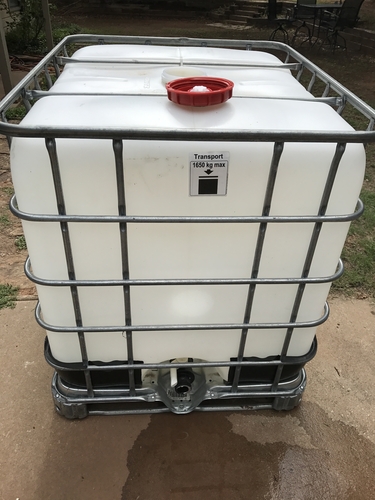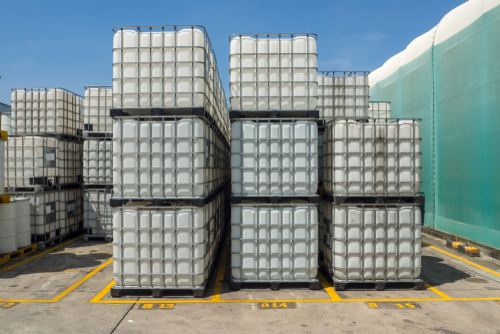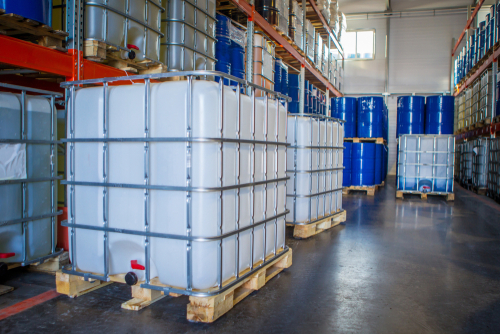The IBC tote–or the Intermediate Bulk Container–has become a stable shipping container over the past 25 years. It’s primarily designed to transport liquids, chemicals, food and other granulated materials. Before the invention of IBC totes, manufacturers and shippers were accustomed to using large cylinders to move these kinds of substances around. But the IBC tote is considered more space- and cost-efficient. Learn more about these unique shipping containers and the person who invented them.
What Is an IBC Tote?
An IBC tote is a cube-shaped stackable container that typically rests on a pallet, so the container can be moved around using a forklift or pallet jack. It keeps the substance secure by placing it in between drums and tanks, which is where the word “intermediate” comes from. IBCs come in a range of sizes, usually 275 gallons or 330 gallons. They’re typically used to transport liquids, chemicals, hazardous materials, adhesives, detergents, food syrups, powdered or granulated food ingredients, paints and raw materials used in industrial production.
While some IBCs are designed for one-time use only, many are reusable, depending on what’s inside. They usually feature white or translucent plastic that’s kept in a galvanized iron cage attached to the pallet underneath. But you can also find a wide variety of IBCs, including those made of wood, steel, aluminum, iron and fiberboard, depending on what you’re shipping. You can even find collapsible IBCs that fold into themselves when there’s nothing being kept inside. This helps you make efficient use of your warehouse when IBCs are just sitting idle.
You can also customize an IBC with exact measurements if you need to do so for shipping purposes, but only if you can find or create a pallet with the same dimensions.

Who Invented the IBC Tote?
The IBC tote was invented by a man named Olivier J. L. D’Hollander in 1992. At the time, he was working for Dow Corning S.A., a multinational corporation located in Midland, Michigan, now the largest silicone product producer in the world. The company specializes in manufacturing over 7,000 products and substances, including sealants, adhesives, lubricants, oils and solvents. As you can see, the company needed a shipping container that could keep these materials intact and contained without taking up too much space. D’Hollander was eventually awarded a U.S. patent for his creation in 1993. In his application for the patent, he described the product as a container that’s foldable, reusable and stackable, suited specifically for transporting, storing and handling liquid materials and “free-flowing powder materials.”
Why Are IBC Totes Superior to Other Shipping Containers?
There are many reasons why the manufacturing industry would turn to IBC totes when shipping, storing and handling these kinds of materials. Before D’Hollander came along, the industry was accustomed to using metal barrels, like those we typically think of when someone is transporting nuclear waste. But cylindric barrels weren’t as easily stackable as the IBC tote. They also had an awkward shape that left large gaps in the warehouse.
To get rid of these inefficiencies, D’Hollander knew the IBC tote had to be in the shape of a cube, so they could fit perfectly into a square room or warehouse. This improves the use of space in a facility, which can be key if a company is processing and handling hundreds of these containers like Dow Corning S.A. This also helps the company make more efficient use of space when shipping these products across long distances. With cylindric barrels, much of the cargo hold would be lost to gaps between the barrels.
Transporting large cubes of liquids also tends to keep the cargo more secure. There’s no chance of the container rolling around or spilling open. When the company packs these containers into a cargo hold, all the containers will be upright and packed together as tightly as possible. This is a huge advantage when shipping potentially dangerous materials and substances. If a container spilled or rolled over, it could spell disaster for the company and its employees.
For over 25 years now, the IBC containers have revolutionized the way the manufacturing industry handles liquids, solvents, granulated substances and hazardous materials. IBC totes make for a more efficient use of space and reduce the chances of a shipment falling over or leaking during transportation. Since D’Hollander invented the IBC tote, many other companies all over the world have made this storage container an integral part of their operations. The IBC tote isn’t going anywhere anytime time soon as it continues to be the preferred choice for those shipping and handling liquids.

